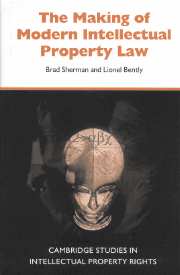Book contents
- Frontmatter
- Contents
- Acknowledgments
- List of abbreviations
- Table of statutes and bills
- Table of cases
- Introduction
- Part 1 Towards a property in intangibles
- Part 2 The emergence of modern intellectual property law
- Part 3 Towards an intellectual property law
- Part 4 Transformations in intellectual property law
- Bibliography
- Index
9 - From creation to object
Published online by Cambridge University Press: 29 May 2025
- Frontmatter
- Contents
- Acknowledgments
- List of abbreviations
- Table of statutes and bills
- Table of cases
- Introduction
- Part 1 Towards a property in intangibles
- Part 2 The emergence of modern intellectual property law
- Part 3 Towards an intellectual property law
- Part 4 Transformations in intellectual property law
- Bibliography
- Index
Summary
As we have seen at various stages in this work, one of the defining features of intellectual property law in the eighteenth and the first half of the nineteenth century was its concern with mental labour and creativity. While the juridical categories operated in a middle ground that oscillated between action and thing, nonetheless the primary focus of the law remained upon the process of creativity. One of the key features of pre-modern intellectual property law was that it assumed that authors, inventors or designers were the bearers of an innate, autonomous will which was somehow pre-social and pre-legal. It was this will, or mental labour, that the law set out to protect and promote. As well as shaping the way the categories were organised and the boundaries drawn, mental (or creative) labour also influenced the duration, scope and nature of the property. It is not too far from the truth to suggest that mental labour was the most influential organising principle of premodern intellectual property law.
Despite the prominent role played by mental labour in pre-modern intellectual property law, by the later part of the nineteenth century the law had shifted its attention away from mental labour and creativity to concentrate more upon the object itself. As the move away from creativity which first began in patent law in the 1860s gradually made its way into and dominated all areas of intellectual property law, the types of arguments which had circulated in the eighteenth and nineteenth centuries began to be discredited. Rather than concentrating on the mental labour embodied in say a work or an invention, the focus of the law fell on works or inventions as entities in their own right. More specifically, instead of concentrating upon the quality of the knowledge embodied within the object or, as was the case earlier, the amount of labour contained within the object, the law came to focus more upon the subject matter as a closed and secure entity. That is, the law moved its focus away from the labour used to create, for example, a book or a machine, to focus, instead, on the book or machine itself.
Information
- Type
- Chapter
- Information
- The Making of Modern Intellectual Property LawThe British Experience, 1760-1911, pp. 173 - 193Publisher: Cambridge University PressPrint publication year: 1999
